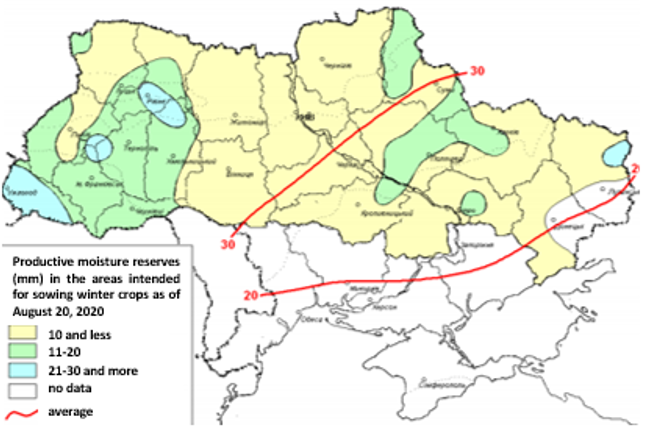Very warm weather prevailed in Ukraine in the second ten-day period of August, there was hot weather on some days and almost dry in most of the country.
The average regional ten-day air temperature in the eastern, Sumy, Dnipropetrovsk, Zaporizhzhya and Kherson regions was close to the norm and in the rest of the territory 1-3 °C above the norm and amounted to 18.6-22.6 °C. The maximum air temperature increased in the western and Zhytomyr regions up to 28-32 °С, in the rest of the territory up to 33-36 °С.
Significant precipitation was noted only in the western regions, and in some areas of the southern regions, short-term intense showers were observed.

In most of the country’s territory, due to a deficit or complete absence of precipitation both during the ten-day period and throughout the month (in many areas of the central regions since July), the air-ground drought continued, intensified and spread. This was facilitated by high temperatures of air and soil, dry wind phenomena. The tilth-top soil under all agricultural crops was almost or completely dry. In many areas of the central and southern regions, complete drying of the meter layer of soil by late crops was noted.
As of August 20, the reserves of productive moisture in the tilth-top soil in the areas intended for sowing winter crops in most regions (with the exception of the southern regions, where moisture reserves will be determined at the end of the first ten-day period of September) were insufficient (11-20 mm) and unsatisfactory (1 – 10 mm), in many areas of the Dnipropetrovsk, in some areas of the Donetsk, Luhansk, Kharkiv, Kirovograd, Cherkasy and Chernihiv regions the soil was completely dry. Sufficient and optimal moistening of the tilth-top soil was noted in certain areas of the Khmelnytskyi, Rivne, Ternopil and Transcarpathian regions – 23-40 mm of productive moisture.
The drought significantly worsened the conditions for the formation of a full-fledged harvest of late agricultural crops, led to a slowdown and completion of the growth of sunflower baskets and corn cobs, the condition of these crops deteriorated rapidly. The lower leaves dried out prematurely, poor pollination was observed in maize, and a significant number of almost empty ears formed. In the areas affected by the most severe drought, the amount of grain on the cob was several times less than the average, and the weight of cobs in the milky ripeness phase was record low. In many areas, the growing season of corn and sunflower crops ended prematurely.
In some areas of the southern, western and central regions, sowing of winter rape continued, in the previously sown areas, the formation of a ladder and 1 true leaf was noted.